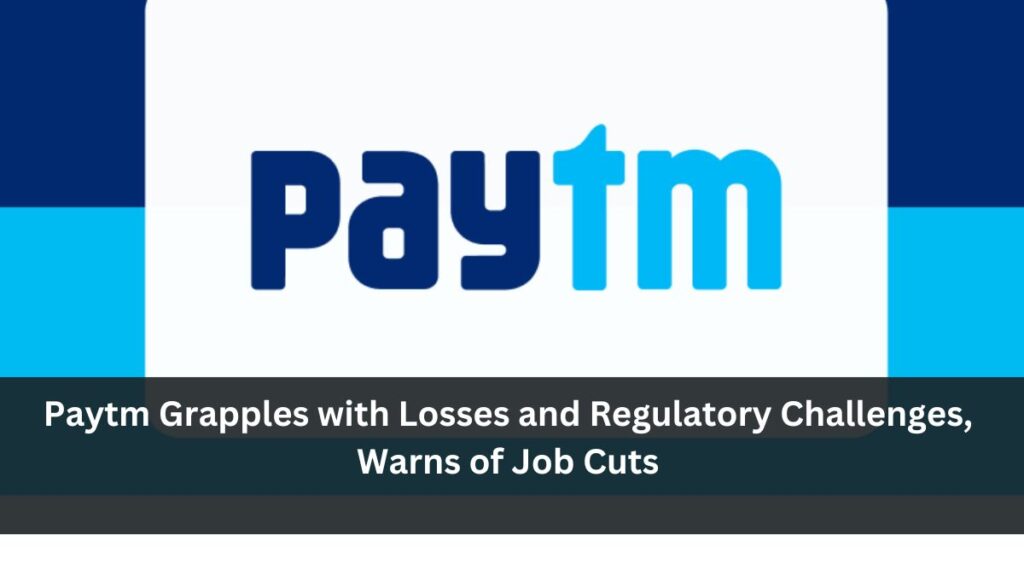Introduction
Paytm, once the darling of the Indian startup ecosystem, has found itself in a precarious position as it navigates a series of financial and regulatory challenges. The digital payments giant, operated by One 97 Communications, recently reported a widening consolidated net loss for the quarter ending March, prompting warnings of potential job cuts as the company seeks to streamline its operations and reduce expenses.
Mounting Losses and Increased Expenses
In its latest earnings report, Paytm revealed that its consolidated net loss had grown to $66.1 million in the January-March quarter, a significant increase from the $20.11 million loss reported in the same period last year. This comes despite the company’s revenue from operations growing by 25% year-on-year to $1.19 billion for the full fiscal year 2024.
The widening losses can be attributed to a combination of factors, including increased expenses across payment processing charges, marketing, employee benefits, and software cloud costs. These mounting costs have weighed heavily on Paytm’s bottom line, prompting the company to take decisive action to curb its expenses and improve its financial position.
Regulatory Clampdown and Its Impact
One of the most significant challenges faced by Paytm in recent months has been the regulatory clampdown imposed by India’s central bank. On March 15, the Reserve Bank of India (RBI) barred Paytm Payments Bank, an associate firm of Paytm, from offering a range of banking services. This move forced Paytm to quickly forge new partnerships with other banks to ensure the continuity of its businesses.
The regulatory action had a direct impact on Paytm’s financial performance, with the company reporting a loss of $27.2 million on the impairment of its investment in Paytm Payments Bank during the quarter. This, coupled with the overall decline in payment volumes and margins, has put immense pressure on the company to adapt and evolve its business model.
Outlook and Analysts’ Perspectives
Despite the challenges, some analysts see positive signs for Paytm’s future. Bernstein analysts noted in a report that the company’s results include “enough data points to suggest that the business is past the bottom in terms of payment volumes and user/merchant traction.” However, they also cautioned that the full impact of the regulatory changes and the resulting drop in payment margins is likely to be felt in the coming quarter.
On a more optimistic note, the analysts highlighted that Paytm’s merchant lending volumes have shown signs of revival in March and April, indicating a potential recovery in this segment of the business. This, along with the company’s substantial cash reserves of $1.03 billion as of March 31, provides some cushioning as Paytm navigates these turbulent times.
Job Cuts and Cost-Cutting Measures
In light of the mounting losses and regulatory challenges, Paytm has warned of potential job cuts as part of its efforts to pare down expenses. The company expects to reduce its annualized employee costs by $48 million to $60 million, signaling a significant restructuring of its workforce.
While job cuts are never an easy decision, they have become an increasingly common response among startups and established companies alike as they grapple with the economic uncertainties and regulatory hurdles in the post-pandemic world. Paytm’s move to streamline its operations and reduce its headcount is a clear indication of the company’s determination to weather the storm and emerge stronger on the other side.
Conclusion
Paytm’s recent financial results and the accompanying warning of job cuts serve as a stark reminder of the challenges faced by even the most successful startups in today’s rapidly evolving business landscape. The company’s struggles with mounting losses, increased expenses, and regulatory setbacks underscore the need for agility, adaptability, and a keen focus on cost management in the face of adversity.
As Paytm navigates this difficult period, it will be crucial for the company to strike a delicate balance between reducing costs and maintaining its competitive edge in the fiercely contested digital payments space. By forging new partnerships, streamlining its operations, and investing in innovation, Paytm has the potential to emerge from this crisis as a leaner, more resilient organization, poised for long-term success in the dynamic world of fintech.

